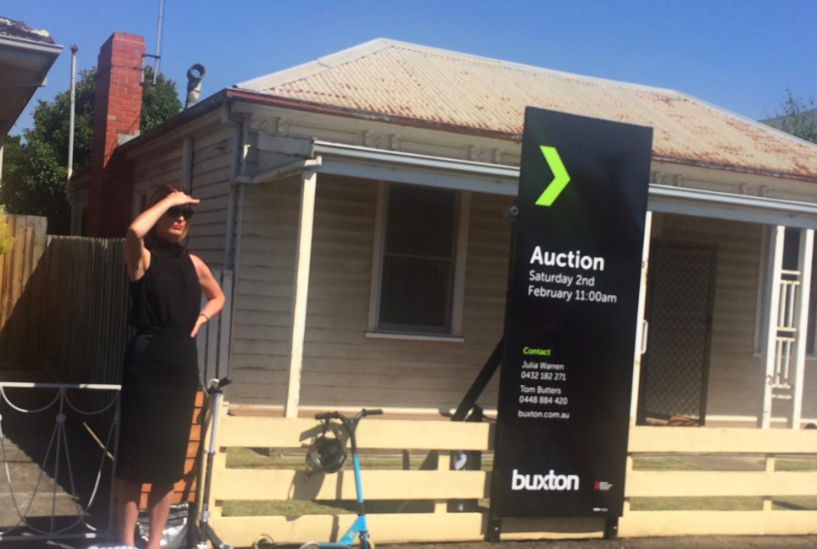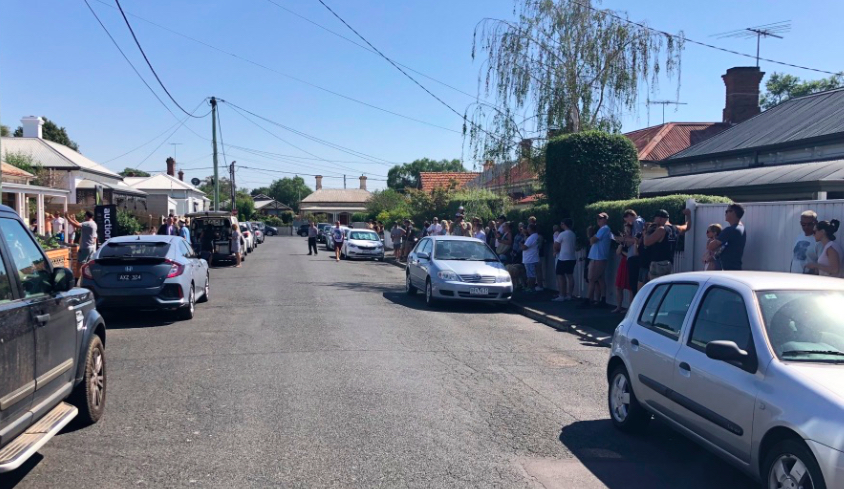With Saturday 2nd Feb signalling another tiny cluster of auctions (albeit with a slightly increased auction clearance rate of 55%), it is fair to note that we won’t see ‘normal’ auction volumes until next Saturday 9th Feb.
While we’ll all be watching out for that magic number when it comes through that evening, we also know that a data point doesn’t make a trend line. We have a lot more late Summer and early Autumn to go until we can definitively agree whether our market has turned a corner.
I’ve predicted that we’ll see an overall increase in our first quarter auction clearance rates (when compared to the last quarter of 2018), but frankly, last year’s Spring felt dismal. We inched down into the 40’s (as an auction clearance rate figure) in those final weeks of the year, and it wasn’t a surprise at the time but it certainly felt gloomy.
This was due to the nasty combination of three strong forces:
- High stock volumes; Melburnians have a terrible habit of all waiting to sell in late Spring. Vendors try to ‘time it right’, when the flowers are out and the sun is shining, but they like to dodge the AFL Grand Final weekend, try to edge around school holiday season and everyone avoids the Melbourne Cup long weekend. What does this leave them?
Very few weekends and a mad scramble towards Christmas, when half of the population is at Chadstone doing their Christmas shopping.
I’ve never understood why a vendor would leave themselves in such a precarious position as to sell when the likelihood of other similar houses to theirs, competing against their campaign could strike. - Difficulty obtaining credit in a marketplace where recent history has shown it used to be much easier; for some, the first time they applied for credit in two years was last year and the resultant delays and bad news came as a rude shock. Gone are the days of private bankers signing off loans or brokers presenting acceptable rough estimates on household spending habits. For those who did want to buy, many found themselves at auction without pre-approval, praying for a pass-in so that they could negotiate a purchase with a finance clause.
- Sentiment; our newspapers and evening television had a field day with the bubble bursting reports. News sells, right?
As the auction clearance rates nose-dived, the headlines continued running, tiny samples of economists suggested our prices would drop 40%, and the Banking Royal Commission sparked up in it’s fury, our late spring market felt like a blood bath for some, and like an opportunist’s dream for others.
Interestingly at the coal face, things didn’t quite reflect what was in the papers.
It wasn’t a blood bath. It was a very mixed market. I spoke to other advocates in Melbourne and we all shared the same observations. We had crazy auctions with multiple bidders producing results that soared past all expectations and smashed the reserve. I note a memorable auction in Sandringham for an original old 1900’s beauty on sizeable land that, by my assessment had an appraised value of $1.85M. I bumped into another experienced advocate at the auction who, afterwards told me that she’d also assessed it at this figure. The property sold for $2.1M, a hefty figure for a total renovation project in the depths of our late Spring market. The $400k-700K priced dwellings in close commuting distance to our CBD continued to be held in high demand by our incentivised first home buyers, who unlike upgraders and multi-property holders, experienced less scrutiny on their loan servicing.
As a property buyer, we certainly worked as hard as we could for our late Spring clients who had chosen to purchase in this period. We faced limited competition, some high-vendor motivation and sourced some properties that our clients’ budgets wouldn’t have had a chance of sourcing a year prior. Things did feel opportunistic and we had a strong number of auction pass-in results for properties that should have otherwise sold under the hammer. For the first time in a long time, we saw A-grade, high-scoring properties passing in. But this didn’t last.
Our best buys and most competitive sale prices achieved were in late November and early December.
 It really was only for that tiny 2-3 week window that we could cherry pick such properties. Once the deluge of quality stock started to become absorbed into December, we found that our competition increased somewhat on the A-grade properties.
It really was only for that tiny 2-3 week window that we could cherry pick such properties. Once the deluge of quality stock started to become absorbed into December, we found that our competition increased somewhat on the A-grade properties.
This is understandable. The last official auction weekend was on 16 December and vendors and agents alike were open to selling prior, and good quality pass-in’s were selling via private sale in the days that followed.
Finance clauses prevailed and vendors got their properties sold.
 2019 marks the start of a subtle change. We are certainly not back to the high’s of our 2017 run (or anywhere near it) but the feeling of desperation and limited buyer interest is not apparent so far this year. Agents are adapting to increasing the proportion of private sales (and have stopped automatically recommending an auction campaign for every sale), vendors are accepting of the current lending conditions and are more willing to entertain a finance clause, and buyer numbers are up; possibly because many have recognised that maybe this is the bottom of this cycle.
2019 marks the start of a subtle change. We are certainly not back to the high’s of our 2017 run (or anywhere near it) but the feeling of desperation and limited buyer interest is not apparent so far this year. Agents are adapting to increasing the proportion of private sales (and have stopped automatically recommending an auction campaign for every sale), vendors are accepting of the current lending conditions and are more willing to entertain a finance clause, and buyer numbers are up; possibly because many have recognised that maybe this is the bottom of this cycle.
“Maybe this is the bottom of this cycle.”
I personally think that the bottom for Melbourne was in late November/early December.
The positive hints to an improved market in 2019 include:
- Lower stock volumes; when supply and demand is more balanced, prices will be more balanced
- Consumers accepting and adjusting to the new credit regimes; buyers are recognising that they need to demonstrate good credit conduct and consistent household/lifestyle expenses to get a loan
- Rental rises in our inner and middle-ring houses; every investor loves a stronger return
- Sentiment; we’re starting to see some good science in the media and the Banking Royal Commission is finally drawing to a close.
The following two pending unknowns continue to taint our market a “jittery’ one;
- Further tough changes that could be applied to our banking sector after the Banking Royal Commission report is handed down
- Our looming Federal Election and questions around what Bill could do, and when he could do it – if he wins.
Looking objectively at the year that was, and the new year that, in essence still is, the overriding opportunity that presents itself to buyers relates to those A-grade property markets that declined in value and presented opportunity that didn’t exist in the year or two prior.
The term “Market Inequality” refers to the differences in median house price across a market or a city. For example, Melbourne’s bottom 10% (bottom decile) holds a median house price currently of $491,000, while it’s 90th percentile holds a value of $1,512,000. The median house price (or the 50th percentile) now holds a raw* median value of $727,000, down significantly from the high’s of 2017. (*Note that raw median is different to the adjusted stratified median that we usually see published. Raw median is considerably lower).
The key thing to note is that the properties from the 50th to 99th percentile (mostly shown in red) were the properties that exhibited the most shift. The buying opportunity for these higher-priced properties increased. In other words, it became slightly easier for people to upgrade in certain markets (credit pending). It also became easier for investors to enter some A-grade markets.
This is an illustration of Market Inequality and last week’s clever Domain article articulates this well.

Our motivation to select assets in the green price bands last year was based on the quest for opportunistic buying in the usuaslly-tightly-held, inner-ring areas for our clients.
Today’s article by Domain’s Melissa Heagney sheds light on this opportunity, and it is certainly congruent with our findings. We were particularly active in the inner-ring markets that offered these opportunities for buyers and investors last year, including; Flemington, Brunswick East and Collingwood.
The opportunities in these locations were palpable and opportunity still exists in such markets.
The question now is – for how much longer?
REGISTER TO OUR NEWSLETTER
INFORMATION
CONTACT US
1A/58 ANDERSON STREET,
YARRAVILLE VIC 3013
0422 638 362
03 7000 6026
CATE@CATEBAKOS.COM.AU
